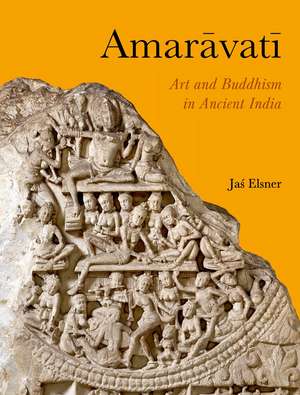Amaravati: Art and Buddhism in Ancient India
Autor Jas Elsneren Limba Engleză Hardback – 17 sep 2024
In this book, Jaś Elsner presents a fresh perspective on the rich visual culture of ancient South Asia, connecting the stupa’s artistic innovations with advancements in Buddhist philosophy and practice. He offers new insights into early Buddhist art in South India, as well as a new understanding of the relationship between early Buddhism and its material culture. The photographs collected here, particularly those featuring objects from the British Museum in London, reveal in detail how the stupa communicated Buddhist teachings and practices to its followers, making this book an invaluable resource for students and scholars alike.
Preț: 311.78 lei
Preț vechi: 356.57 lei
-13% Nou
Puncte Express: 468
Preț estimativ în valută:
59.66€ • 62.29$ • 49.38£
59.66€ • 62.29$ • 49.38£
Carte disponibilă
Livrare economică 15-22 martie
Livrare express 01-07 martie pentru 104.50 lei
Preluare comenzi: 021 569.72.76
Specificații
ISBN-13: 9781789148695
ISBN-10: 1789148693
Pagini: 308
Ilustrații: 125 color plates, 25 halftones
Dimensiuni: 190 x 250 x 30 mm
Greutate: 1.16 kg
Editura: REAKTION BOOKS
Colecția Reaktion Books
ISBN-10: 1789148693
Pagini: 308
Ilustrații: 125 color plates, 25 halftones
Dimensiuni: 190 x 250 x 30 mm
Greutate: 1.16 kg
Editura: REAKTION BOOKS
Colecția Reaktion Books
Notă biografică
Jaś Elsner is professor of late antique art at the University of Oxford. He is author or editor of many books including Roman Eyes: Visuality and Subjectivity in Art and Text.
Cuprins
Preface
Introduction
Part I: The Great Stupa at Amaravati
1 Approach and Circumambulation
2 The Inscriptions and Their Messages
Part II: Narrative Sculpture
3 Visual Storytelling and the Vision of Karma
Part III: The Wider Indian Context
4 Theatricality
5 Cosmography
Part IV: Icon and Replication
6 Buddhapada: Symbolism, Visual Epitome and the Creation of Icons
7 Systems of Representation
Conclusion
References
Bibliography
Acknowledgements
Photo Acknowledgements
Index
Introduction
Part I: The Great Stupa at Amaravati
1 Approach and Circumambulation
2 The Inscriptions and Their Messages
Part II: Narrative Sculpture
3 Visual Storytelling and the Vision of Karma
Part III: The Wider Indian Context
4 Theatricality
5 Cosmography
Part IV: Icon and Replication
6 Buddhapada: Symbolism, Visual Epitome and the Creation of Icons
7 Systems of Representation
Conclusion
References
Bibliography
Acknowledgements
Photo Acknowledgements
Index
Recenzii
"While it is well-known that some of the greatest Buddhist masters of ancient India hailed from southern India, there seems to be no satisfactory historical understanding of the seminal role Buddhism in south India might have played in the very formation of what came to be known as Mahayana Buddhism. Combining the intricate methods of art history with critical textual and historical inquiry of Buddhist studies, Jas Elsner offers a rich and engaging account of the devotional energy, vibrancy of philosophical debates, and artistic creativity that must have given rise to the emergence of the Amaravati Stupa, indisputedly one of the greatest Buddhist monuments of ancient India. An eye-opening book that I cannot recommend more highly."
"This precious book looks at the great stu¯pa of Amara¯vati¯ – one of the most important monuments in the ancient world – from seemingly inexhaustible perspectives. It leads the reader to see its monumental form and amazing reliefs, to read its intriguing inscriptions, and to think about its visual, cultural, and ideological connections with the long history of stu¯pa construction, Buddhist mythology and ancient Indian narrative traditions, ritual function and cosmological vision, theatricality and the agency of dance, and philosophical questions evoked by the Buddha’s multiple bodies and foot-prints, all embedded in the building’s architectural and sculptural programs."
"Amaravati marks a revolutionary approach to 'visual Buddhology' that triangulates a hermeneutics of iconic objects with texts and practice traditions. In doing so, it breaks down disciplinary barriers, restores the Indian cultural element in Indian Buddhist studies and revises arguments about the rise of Mahayana in early India."
